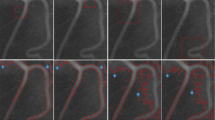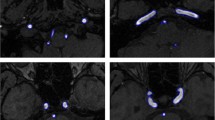Abstract
Due to the complex topological structure of the coronary artery and the uneven distribution of the contrast agent, the angiography images are inevitably blurred and has low contrast, which causes great difficulty in process of segmentation. For this problem, a two-steps segmentation algorithm based on Hessian matrix and level set is proposed in this paper. Firstly, potential blood vessels of coronary images are preliminary extracted via Hessian matrix eigenvalues feature vectors of the geometric features and the response function. Then a novel regularization and area constraint is introduced into the local data energy fitting functional. Finally, the precision of Coronary Artery image is obtained in the evolution of the level set function. Experiments show that our proposed algorithm has better performance to these comparison segmentation algorithms.




Similar content being viewed by others
References
Brieva, J., Coronary artery segmentation in X-Ray Angiographic image by means of a shape based level set method. Health Care Exchanges. IEEE, 2013.
Feng, C., and Hu, Y., Segmentation of Coronary Artery Using Region Based Level Set with Edge Preservation. Journal of Medical Imaging & Health Informatics 6(7):1727–1731, 2016.
Wang, Y., and Liatsis, P., An Automated Method for Segmentation of Coronary Arteries in Coronary CT Imaging. Developments in E-Systems Engineering . IEEE Computer Society, 2010.
Popa, T. R., and Mocanu, M. L., Coronary artery segmentation in cardiac angiography images based on a hybrid approach. System Theory, Control & Computing. IEEE, 2013.
Jian-Feng, S., Dao-Yin, Y. U., Xiao-Dong, C. et al., Level set method image segmentation based on fuzzy clustering method and C-V model. Chinese Journal of Interventional Imaging and Therapy 10(8):498–502, 2013.
Soleimanifard, S., Schär, M., Hays, A. G. et al., Vessel centerline tracking and boundary segmentation in coronary MRA with minimal manual interaction. IEEE International Symposium on Biomedical Imaging. IEEE, 2012.
Soleimanifard, S., Schar, M., Hays, A. G., et al. [IEEE 2012 IEEE 9th International Symposium on Biomedical Imaging (ISBI 2012) - Barcelona, Spain (2012.05.2–2012.05.5)] 2012 9th IEEE International Symposium on Biomedical Imaging (ISBI) - Vessel centerline tracking and boundary segmentation in coronary MRA with minimal manual interaction. Proceedings, 1417–1420, 2012.
Oueslati, C., Mabrouk, S., Ghorbel, F., et al. A Coronary Artery Segmentation Method Based on Graph Cuts and MultiScale Analysis. International Workshop on Representations. Springer, Cham, 2016.
Zhu, W. B., Li, B., Tian, L. F. et al., A Novel Coronary Artery Skeleton Extracting Method Based on Multiple Hypothesis Tracking. Journal of Medical Imaging & Health Informatics 4(6):832–839, 2014 (8).
Turani, Z., Zoroofi, R. A., and Shirani, S., 3D automatic segmentation of coronary artery based on hierarchical region growing algorithm (3D HRG) in CTA data- sets. Biomed. Eng. IEEE, 2014.
Kim, D. Y., and Park, J. W., Multiple-phase segmentation approach for blood vessel extraction on cervical MRA image sequence. Magn. Reson. Imaging 27(2):256–263, 2009.
Zhou, C., Chan, H. P., Chughtai, A. et al., Automated segmentation and tracking of coronary arteries in ECG-gated cardiac CT scans - art. no. 69150O. Proceedings of SPIE - The International Society for Optical Engineering 6915:69150O–69150O-7, 2008.
Cervantes-Sanchez, F., Cruz-Aceves, I., Hernandez-Aguirre, A., et al. Coronary artery segmentation in X-ray angiograms using gabor filters and differential evolution. Applied Radiation and Isotopes, S0969804317301124, 2017.
Van Rosendael, A. R., Kroft, L. J., Broersen, A. et al., Relation between quantitative coronary CTA and myocardial ischemia by adenosine stress myocardial CT perfusion. J. Nucl. Cardiol., 2016.
Zhang, D. P., and Zhang, D. P., Coronary Artery Segmentation and Motion Modelling. Imperial College London, 2010.
Yihui, C., Kang, C., Xianjing, Q. et al., Automatic Lumen Segmentation in Intravascular Optical Coherence Tomography Images Using Level Set. Computational and Mathematical Methods in Medicine 2017:1–11, 2017.
Wen-Bo, Z., Bin, L. I., Lian-Fang, T. et al., A New Coronary Artery Skeleton Extraction Method Based on Layered Multiple Hypothesis Tracking. Acta Automat. Sin., 2014.
Wang, Z., Kyono, H., Bezerra, H. G. et al., Semiautomatic segmentation and quantification of calcified plaques in intracoronary optical coherence tomography images. J. Biomed. Opt. 15(6):061711, 2010.
Jodas, D. S., Pereira, A. S., Tavares, J. M. R. S., Automatic segmentation of the lumen region in intravascular images of the coronary artery. Medical Image Analysis, S1361841517300920, 2017.
Sironi, A., Turetken, E., Lepetit, V. et al., Multiscale Centerline Detection. IEEE Trans. Pattern Anal. Mach. Intell. 38(7):1–1, 2015.
Mukhopadhyay, A., Qian, Z., Bhandarkar, S. M. et al., Morphological Analysis of the Left Ventricular Endocardial Surface Using a Bag-of-Features Descriptor. IEEE Journal of Biomedical and Health Informatics 19(4):1483–1493, 2015.
Kai-jian Xia, Hong-sheng Yin, Yu-dong Zhang. Deep Semantic Segmentation of Kidney and Space-Occupying Lesion Area Based on SCNN and ResNet Models Combined with SIFT-Flow Algorithm. Journal of medical systems, (2019) 43:2
Zheng, Y., Loziczonek, M., Georgescu, B. et al., Machine learning based vesselness measurement for coronary artery segmentation in cardiac CT volumes. Proc. SPIE 7962(3):298–306, 2011.
Lesage, D., Angelini, E. D., Bloch, I. et al., Bayesian maximal paths for coronary artery segmentation from 3D CT angiograms. International Conference on Medical Image Computing & Computer-assisted Intervention. Med Image Comput Comput Assist Interv, 2009.
Gao, Honghao; Duan, Yucong; Miao, Huaikou; Yin, Yuyu. An Approach to Data Consistency Checking for the Dynamic Replacement of Service Process, IEEE Access, 2017, 5(1):11700-11711.
Pengjiang Qian, Yizhang Jiang, Zhaohong Deng, Lingzhi Hu, Shouwei Sun, Shitong Wang, Raymond F. Muzic Jr., Cluster Prototypes and Fuzzy Memberships Jointly Leveraged Cross-Domain Maximum Entropy Clustering.IEEE Transaction onCybernetics, 46(1): 181-193
Khan, M. F., Wesarg, S., Gurung, J. et al., Facilitating coronary artery evaluation in MDCT using a 3D automatic vessel segmentation tool. Eur. Radiol. 16(8):1789–1795, 2006.
Yizhang Jiang, Dongrui Wu, Zhaohong Deng, Pengjiang Qian, Jun Wang, Guanjin Wang, Fu-Lai Chung, Kup-Sze Choi, Shitong Wang. Seizure Classification from EEG Signals using Transfer Learning, Semi-Supervised Learning and TSK Fuzzy System. IEEE Transaction on Neural Systems & Rehabilitation Engineering, 25(12):2270-2284
Shahzad, R., Kirişli, H., Metz, C. et al., Automatic segmentation, detection and quantification of coronary artery stenoses on CTA. The International Journal of Cardiovascular Imaging 29(8):1847–1859, 2013.
Author information
Authors and Affiliations
Corresponding author
Ethics declarations
Conflict of interest
We declare that we have no conflict of interest.
Human and animal rights
The paper does not contain any studies with human participants or animals performed by any of the authors.
Informed consent
Informed consent was obtained from all individual participants included in the study.
Additional information
Publisher’s Note
Springer Nature remains neutral with regard to jurisdictional claims in published maps and institutional affiliations.
This article is part of the Topical Collection on Image & Signal Processing
Rights and permissions
About this article
Cite this article
Ge, S., Shi, Z., Peng, G. et al. Two-Steps Coronary Artery Segmentation Algorithm Based on Improved Level Set Model in Combination with Weighted Shape-Prior Constraints. J Med Syst 43, 210 (2019). https://doi.org/10.1007/s10916-019-1329-y
Received:
Accepted:
Published:
DOI: https://doi.org/10.1007/s10916-019-1329-y




